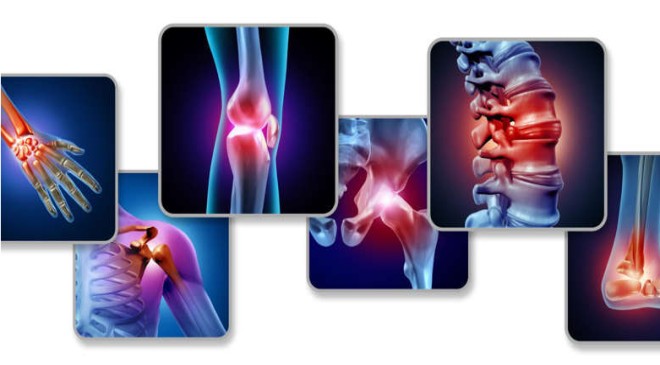Psoriatic arthritis 101
If you are one of the eight million people in the U.S. with psoriatic arthritis, you know joint pain is often just the start of living with this condition. Psoriatic arthritis (PsA) is a chronic inflammatory disease with pain and inflammation in your joints, and in the spots where your tendons and ligaments connect to your bones.
A growing body of evidence suggests that the undercurrent of inflammation driving psoriatic arthritis may increase the risk of other health problems down the road, including heart disease. Some good news? Treating it early and aggressively may lower these risks and prevent lasting joint damage—as Monica Schwartzman, MD, a rheumatologist at the Hospital for Special Surgery in New York City, tells TheHealthy: “An awareness of ways this disease can present and early identification is essential so we can intervene early with a treatment that will help us prevent other related diseases and more permanent joint damage and functional impairments down the line.
Here’s what you need to know about psoriatic arthritis, including the risks, triggers, and treatment options.
Here’s who may be at greatest risk for psoriatic arthritis:
Psoriatic arthritis typically strikes people between the ages of 30 and 50, according to the National Psoriasis Foundation (NPF). The following three issues may pose as psoriatic arthritis risk factors:
Psoriasis
About one-third of people with psoriasis will develop psoriatic arthritis—in fact, Dr. Schwartzman calls psoriasis “the biggest clinical risk factor for developing psoriatic arthritis.” More specifically, she notes that if psoriasis affects your scalp or skin folds and/or travels with nail changes, you are even more likely to develop psoriatic arthritis. (What is psoriasis, anyway? It’s more than skin-deep—here’s the drill on psoriasis symptoms, causes, and treatments.)
The NPF suggests that for many, psoriatic arthritis starts about 10 years after psoriasis symptoms first appear. But, this can vary: some people develop skin and joint symptoms simultaneously, while others may be diagnosed with arthritis first.
Is it possible to develop psoriatic arthritis without psoriasis? It is, says Dr. Schwartzman, but this is pretty rare. Sometimes you may have psoriasis but not even know it because it’s hidden in your scalp or skin folds.
Other inflammatory diseases
PsA also travels with other inflammatory diseases, including inflammatory bowel disease and or uveitis, a type of eye inflammation.
Family history
Having a family history of psoriasis or psoriatic arthritis will also increase your risk of developing psoriatic arthritis. According to the National Library of Medicine, about 40 percent of people with psoriatic arthritis have at least one close family member with psoriasis or psoriatic arthritis.
What’s the connection? Dr. Schwartzman says certain genes may predispose an individual to develop psoriatic arthritis.
Psoriatic arthritis symptoms
Sometimes psoriatic arthritis develops slowly, producing only mild symptoms, but it can also come on quickly—and severely. There are periods of flare-ups, and symptom-free remissions.
Psoriatic arthritis doesn’t always look the same from person to person, Dr. Schwartzman says. “There is joint pain and joint swelling, and one of the tough things is that the pattern can be quite heterogeneous,” she says. “It can be in the knees and elbows, small joints of hands, or the spine. It really runs the spectrum.”
Adds David Pisetsky, MD, chief of rheumatology at Duke University Medical Center in Durham, North Carolina: “Psoriatic arthritis can be distinguished from other forms of inflammatory arthritis because of the association with psoriatic skin disease although some patients develop psoriatic arthritis before the skin disease is evident.”
Along with the discomfort and swelling, psoriatic arthritis may cause stiffness in your joints. Your joints may even feel so enflamed that they’re warm to the touch from the surface of your skin.
People with psoriatic arthritis may also develop sausage-like swelling in one or more of their fingers or toes. The medical name for this is dactylitis, according to Dr. Schwartzman.
Other clues that may suggest your joint pain is due to psoriatic arthritis include:
- Pain in and around your feet and ankles
- Nail changes, such as pitting or separation from the nail bed
- Low back pain
- Enthesitis or inflammation of the enthesis, where a tendon or ligament attaches to the bone.
Psoriatic arthritis causes and triggers
At the present time, research hasn’t identified precisely what causes psoriatic arthritis, according to the American College of Rheumatology. Most experts agree that genes play a role. Also, sometimes psoriatic arthritis can occur after an injury to a joint or infection that revs up your immune system.
Flares can occur for many reasons, including:
- Skipping or stopping your medications
- Skin trauma, including sunburn
- Stress
- Smoking
- Alcohol
- Sleep loss
Dr. Schwartzman says one wise way to help you recognize and avoid flare-up triggers is to keep a symptom diary. This may help you recognize patterns between some lifestyle choices and psoriatic arthritis flare-ups.
Diagnosing psoriatic arthritis
As many patients and healthcare professionals know, diagnosing psoriatic arthritis is a significant challenge that comes with the condition. “There is no good laboratory test that can say, ‘You definitely have psoriatic arthritis,'” Dr. Schwartzman says. Your medical provider may perform a physical exam that assesses your joints, X-ray imaging results, consideration for your personal and family history, plus some lab tests that can indicate inflammation. However, when it comes to blood work for psoriatic arthritis, psoriatic arthritis often travels with general markers of inflammation in the blood. This is in contrast to some other rheumatological diseases, which often have specific antibodies associated with them.
With this in mind, the presence of certain antibodies such as rheumatoid factor or anti-CCP antibodies may indicate another type of joint disease such as arthritis, according to the National Library of Medicine. A test for a gene called HLA-B27 may also help make a diagnosis.
Dr. Pisetsky says a specific diagnostic can help narrow down a psoriatic arthritis diagnosis. “Some patients with psoriasis who have joint pain may therefore have [osteoarthritis] with psoriasis, rather than psoriatic arthritis,” he explains. “X-rays can help in the distinction.”
Types of psoriatic arthritis
Another complexity? As the National Library of Medicine explains, there are several types of psoriatic arthritis. Your symptoms may help determine which psoriatic arthritis type you have:
- Distal interphalangeal predominant psoriatic arthritis affects the ends of your fingers and toes.
- Asymmetric oligoarticular psoriatic arthritis involves different joints on each side of the body.
- Symmetric polyarthritis affects the same joints on each side of your body. (Asymmetric oligoarticular and symmetric polyarthritis are the two most common types of psoriatic arthritis.)
- Spondylitis is inflammation in the joints between the vertebrae of your spine.
- Arthritis mutilans is a relatively rare form of psoriatic arthritis. It involves severe inflammation that damages the joints in your hands and feet, resulting in deformities and difficulty with movement.
- How to treat psoriatic arthritis

While it might seem like psoriatic arthritis is still a puzzle that research is continuing to figure out, science is evolving toward more answers. “It’s a very exciting time in psoriatic disease from a treatment perspective,” says Dr. Schwartzman. “Our treatment armamentarium has widely expanded with new medication approvals and guidelines that support their use. It’s a very promising time.”
Dr. Pisetsky agrees. “There are now many approved therapies for PsA as well as psoriatic skin disease,” he says. “These agents are very effective and can reduce pain and swelling of the joints as well as skin lesions.”
Psoriatic arthritis treatments
Traditional DMARDs
Conventional disease-modifying antirheumatic drugs (DMARDs) such as methotrexate, leflunomide, and sulfasalazine take a broad approach and suppress the entire immune system, according to the Arthritis Foundation.
Biologics
Biologic drugs may shut down key players in your immune system to help decrease inflammation. Dr. Schwartzman says these drugs can have such an impact that they’ve revolutionized the treatment of inflammatory disease, including psoriatic arthritis.
The most recent guidance from the American College of Rheumatology (ACR) and the National Psoriasis Foundation (NPF) recommends a particular type of biologic. It’s known as a TNF- blocker and is the first line of treatment for people with active psoriatic arthritis who have never been treated, and for those who didn’t improve with other treatments. The guidelines also suggest a patient may switch to a different TNF blocker if the first one doesn’t work.
TNF blockers approved for psoriatic arthritis include:
- Adalimumab (Humira)
- Certolizumab pegol (Cimzia)
- Etanercept (Enbrel)
- Golimumab (Simponi, Simponi Aria)
- Infliximab (Remicade)
Other biologic drugs approved to treat psoriatic arthritis target different proteins in your immune system. They include:
- Secukinumab (Cosentxy) and ixekizumab (Taltz) which block Interleukin (IL-17)
- Ustekinumab (Stelara), which blocks both IL-12 and 23.
- Apremilast (Otezla), which blocks phosphodiesterase 4 (PDE4), an enzyme involved in inflammation.
- Abatacept (Orencia), which works by attaching to the surface of inflammatory cells and blocking their communication with each other.
- Tofacitinib (Xeljanz/Xeljanz XR) and upadacitinib (Rinvoq), which are Janus kinase inhibitors (JAK inhibitors) that block enzymes associated with inflammation.
Not everyone with psoriatic arthritis is a candidate for a TNF blocker, including those with a history of heart failure or recurrent infections, Dr. Schwartzman says.
The doctor adds that some available biologics target specific characteristics of psoriatic arthritis or psoriasis or have different side effect profiles. This can help guide the choice of therapy.
There is no biomarker yet that can help determine that a particular patient with psoriatic arthritis will do best with a particular medication, she says.
Other Psoriatic Arthritis Treatments
Your doctor will choose a therapy based on your symptoms and how much they bother you, any other health problems you may have, your insurance, and your preferences. Some are pills, while others are administered in the form of an injection or infusion.
Other drugs can relieve symptoms of psoriatic arthritis, such as joint pain, but don’t get at its cause. These include:
- Nonsteroidal anti-inflammatory drugs
- Acetaminophen
- Steroid injections
Lifestyle changes and psoriatic arthritis
In addition to medication as part of a comprehensive psoriatic arthritis treatment plan, lifestyle modifications might also be necessary. These may include:
Physical Therapy
If joint pain and inflammation affect your ability to walk or exercise, a physical therapist can work with you to improve your range-of-motion and preserve or restore joint motion. Also, check out these 15 life hacks for arthritis pain relief.
Smoking Cessation
If you smoke, quit—and if you don’t smoke, well…don’t start. Smoking not only increases the risk of developing psoriatic arthritis (along with other diseases); Dr. Schwartzman says can also worsen your psoriatic arthritis and trigger a flare-up.
Weight loss
If you are overweight or obese, losing weight can take pressure off your painful joints. Weight loss may also help reduce your systemic inflammation and lower your risk for heart disease.
Eat a healthy diet
There is no psoriatic arthritis diet, but there are certain foods to eat for inflammation. The Arthritis Foundation suggests fatty fish such as salmon, trout, mackerel, and sardines can calm inflammation, as can walnuts, pumpkin seeds, flaxseeds, flaxseed oil, and olive oil. It’s also a good idea to include lean protein and eat colorful vegetables for their vitamins, minerals, and antioxidants that may help calm inflammation.
Exercise
Regular exercise has many benefits for your psoriatic arthritis symptoms, according to the NPF. It can keep your joints flexible, reduce inflammation and pain and help keep your weight down and energy and spirits up. The Arthritis Foundation notes you shouldn’t be too ambitious when you’re starting a fitness program for psoriatic arthritis, and they remind you to keep it low-impact. (Running on sore joints is probably not the most inspiring workout, after all.)
Also, be sure to get a green light from your doctor before you set off on a new exercise regimen
How Serious Is Psoriatic Arthritis?
Left untreated or under-treated, psoriatic arthritis can result in permanent joint damage, Dr. Pisetsky says. It may also increase your chances of developing metabolic syndrome and cardiovascular disease.
Other diseases that may travel with a psoriatic arthritis diagnosis including type 2 diabetes and non-alcoholic fatty liver disease, liver inflammation and excess fat in liver cells and can lead to irreversible liver damage, according to the Arthritis Foundation.
The hope is that identifying this disease early and treating the simmering inflammation aggressively will prevent these consequences.

























